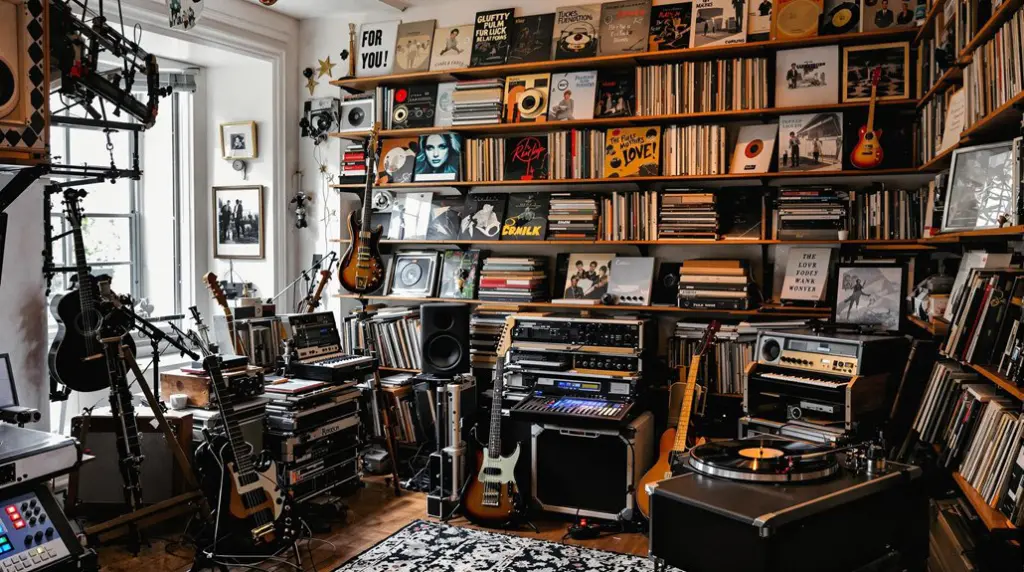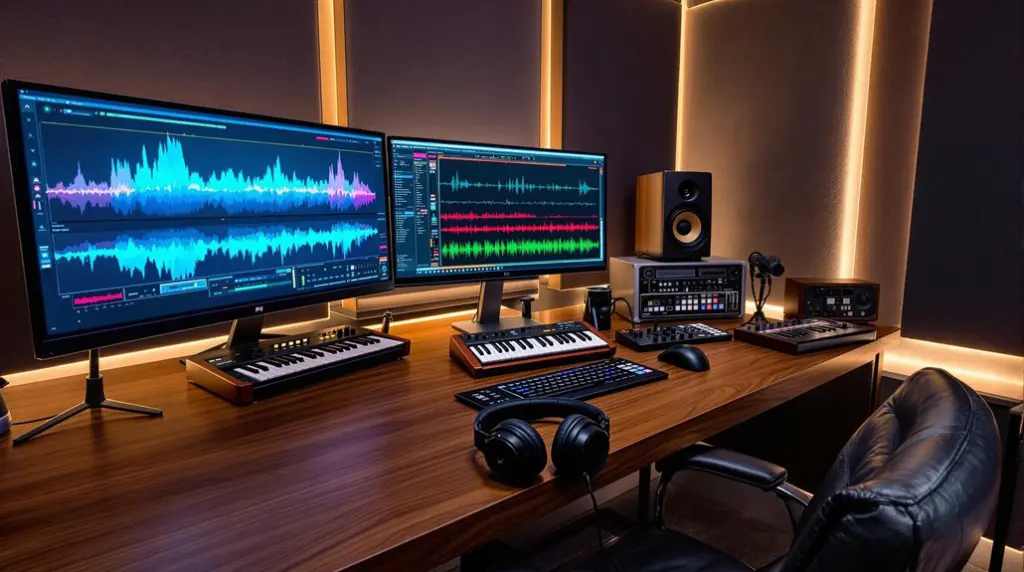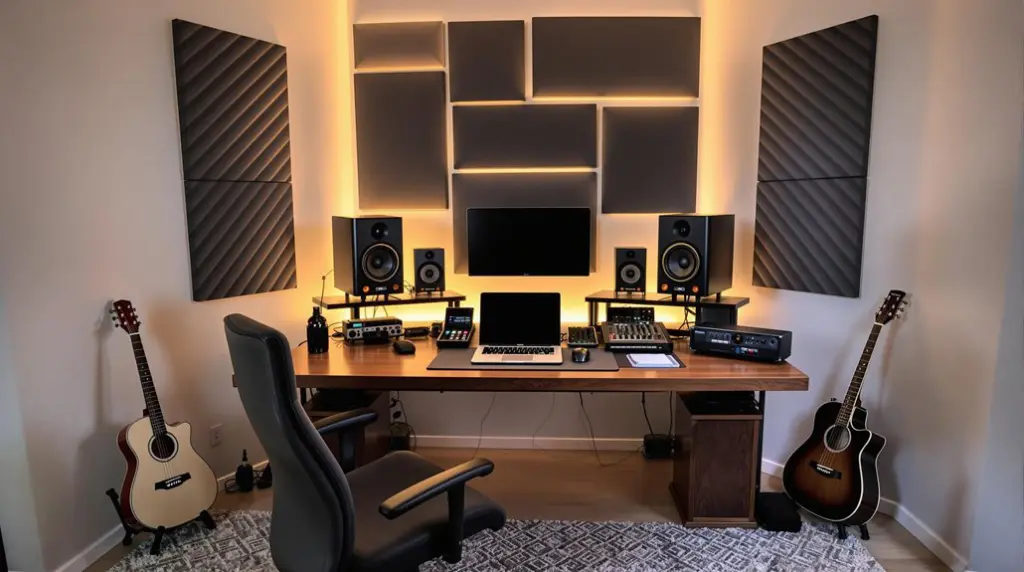To masterfully use reverb on vocals, begin by understanding various types like room, hall, and plate reverb. Adjust decay time appropriately; shorter settings suit faster tempos, while longer ones enhance slower songs. Utilize pre-delay to enhance vocal clarity, typically between 10 to 30 milliseconds. Achieve a proper balance between wet and dry signals, keeping wet levels between 10% and 30%. Implement contrast by using close reverb for lead vocals and distant reverb for depth. Finally, avoid common mistakes, such as overuse, and adhere to best mixing practices. There are additional nuanced techniques to explore further in this area.
Key Takeaways
- Start with subtle reverb settings, gradually increasing to find the right balance without overwhelming the mix or causing muddiness.
- Adjust pre-delay to enhance vocal clarity, typically keeping it between 10 to 30 milliseconds for optimal articulation.
- Tailor decay times to match the song’s tempo; use shorter decay for fast-paced genres and longer for ballads.
- Implement EQ on reverb sends to cut low frequencies, ensuring the vocal remains clear and distinct in the mix.
- Utilize dynamic automation to adjust reverb levels, emphasizing emotional peaks and maintaining rhythmic integrity throughout the track.
Understanding Vocal Reverb
While reverb is often regarded as a mere embellishment in vocal production, its true significance lies in its ability to simulate natural acoustic environments, thereby enhancing the overall sound quality of recordings.
Vocal reverb encompasses various types, including room, hall, plate, and spring, each with distinct characteristics that influence the vocal sound. For instance, room reverb offers intimacy, while hall reverb provides spaciousness.
Critical parameters, such as early reflections, delay, and decay times, dictate how these reverb sounds interact with the vocal performance. Mastery of these settings is vital, as they should align with the emotional intention of the song.
Proper application techniques, including pre-delay adjustments, guarantee vocal clarity and enhance the mix without overwhelming the primary vocal track. Additionally, understanding the origins of reverb can significantly improve your approach to vocal production.
Choosing the Right Type
Selecting the appropriate type of reverb is critical in achieving the desired tonal quality and emotional impact of vocal recordings. When choosing the right type, consider the specific genre and context of the vocals.
Room reverb is ideal for intimate recordings, enhancing presence without overpowering the voice. Conversely, hall reverb excels in ballads, providing depth and a lush sound.
For genres like jazz and soul, plate reverb delivers clarity and richness essential for vocal tails. Spring reverb introduces a mechanical character that suits rock and retro styles.
Finally, convolution reverb replicates real acoustic spaces, offering realistic effects tailored to the desired environment. Each type serves distinct purposes, making informed choices crucial for superior vocal enhancement. Additionally, understanding the different types of reverb can help you choose the most fitting option for your vocal tracks.
Adjusting Decay Time
Precision in adjusting decay time is essential for aligning the reverb effect with the musical context and tempo of a track.
In popular music, shorter decay times, typically between 0.5 to 1 second, are ideal for fast-paced genres like pop and dance, as they maintain vocal clarity and rhythmic integrity.
Conversely, ballads and slower songs benefit from longer decay times of 2 seconds or more, creating a rich, immersive sound that enhances emotional depth.
Additionally, the decay time should complement the vocal range; higher-pitched vocals often require shorter decay to prevent muddiness, while lower-pitched vocals can accommodate longer decay without losing definition.
Experimentation and automation can further refine the reverb on vocals, emphasizing key lyrical moments. Understanding different reverb types can also help in selecting the most suitable effect for the vocal style.
Utilizing Pre-Delay
Pre-delay is an essential effect in vocal processing, defined as the time gap between the original signal and the onset of reverb, typically ranging from 10 to 30 milliseconds.
This adjustment not only enhances vocal clarity by separating the voice from the reverb tail but also aids in maintaining rhythmic integrity within a track’s groove. Additionally, longer pre-delay settings can improve vocal articulation, ensuring the voice remains distinct within the mix.
Defining Pre-Delay Effect
The pre-delay effect serves as an essential element in vocal processing, defining the temporal relationship between the dry vocal signal and the onset of reverb. Typically measured in milliseconds, pre-delay allows for clarity and separation in the mix, ensuring that the listener can clearly hear the reverb without it muddying the vocal attack.
A rule of thumb for most vocal tracks is to set pre-delay between 10 to 30 milliseconds, with adjustments based on the song’s tempo and style. Longer pre-delay times can enhance a sense of spaciousness in larger mixes, while shorter times foster intimacy in softer vocals.
Experimentation with these settings can greatly influence the overall feel and clarity of the mix, enhancing emotional delivery.
Adjusting Timing and Rhythm
While crafting a vocal mix, adjusting timing and rhythm through the use of pre-delay can greatly enhance the overall sonic environment.
Pre-delay settings create a brief gap between the vocal sound and the reverb onset, maintaining clarity and supporting the vocal groove. Shorter pre-delay times (10-20 ms) keep vocals tight, ideal for faster tempos, while longer times (30-50 ms) enhance separation and space, making them suitable for slower tempos.
This tempo matching guarantees that rhythmic spacing complements the overall musical flow. By experimenting with different pre-delay settings across various vocal sections, such as verses and choruses, one can effectively enhance dynamic contrast, ultimately enriching the song’s storytelling without compromising vocal prominence in the mix.
Enhancing Vocal Clarity
An effective vocal mix hinges on clarity, which can be greatly enhanced through the strategic application of pre-delay in reverb settings. Pre-delay creates a gap between the initial vocal sound and the reverb tail, ensuring vocal presence remains intact.
To achieve ideal clarity enhancement, consider the following:
- Timing: Start with a pre-delay of 20-50 milliseconds to maintain intelligibility before the reverb effect.
- Tempo Adaptation: Adjust pre-delay based on the song’s tempo; shorter delays for faster tempos, longer for slower ones, enhancing reverb depth.
- Parameter Experimentation: Tweak pre-delay alongside decay time and reverb type to prevent vocals from sounding washed out, ensuring emotional impact and clarity throughout the mix.
Balancing Wet and Dry Signals
Achieving a balanced wet and dry signal is essential for maintaining vocal clarity within a mix, typically requiring a reverb mix that ranges between 10% to 30% wet for most musical styles.
Employing effective reverb techniques, such as adjusting pre-delay settings, allows the dry signal to assert its presence before the reverb tail, enhancing vocal presence without sacrificing clarity.
Additionally, tailoring decay times according to the song’s tempo guarantees that the reverb complements the track; shorter times for upbeat songs and longer for slower ballads.
Utilizing EQ on the reverb send to cut low frequencies can further enhance mix clarity, while automating reverb levels throughout different sections dynamically balances the wet and dry signals, allowing for emotional depth without muddling the vocals. Moreover, applying a high-pass filter around 200Hz can effectively remove unwanted low-end muddiness from the reverb signal.
Experimenting With Layering
Layering different types of reverb can considerably boost vocal production, creating a sound that is both immersive and textured. By combining various reverb styles, you can achieve intricate vocal textures that enhance the mixing techniques used in your track.
Consider the following:
- Short Room Reverb – Provides immediate depth and intimacy, maintaining clarity.
- Long Plate Reverb – Adds lush sustain and spatial qualities, enriching the overall sound.
- Automation – Dynamically adjusts reverb levels to highlight emotional peaks within the vocal performance.
Utilizing dual-engine reverb plugins, such as Relab LX480, allows for precise control over these parameters. Additionally, employing EQ adjustments on reverb sends guarantees that the layered effects complement the vocals without overwhelming the mix, preserving rhythmic clarity. Experimenting with pre-delay settings can further enhance clarity by maintaining separation between the direct sound and the reverb effect, creating a more polished vocal mix.
Timing Considerations
Timing considerations are crucial in selecting appropriate reverb types to enhance vocal tracks. Longer reverb tails can obscure rhythmic clarity, particularly in faster tempos, while shorter settings maintain the groove essential for genres like dance music.
Employing pre-delay effectively separates the vocal from the reverb tail, preserving timing effects that contribute to the song’s overall rhythmic structure.
Additionally, filtering and sidechaining techniques serve to control reverb’s frequency response, preventing it from overwhelming the original vocal sound. Implementing decay time adjustments is essential for maintaining clarity and preventing muddiness in the mix.
Implementing Contrast
Implementing contrast in vocal reverb can greatly enhance a mix by juxtaposing close vocal sounds with distant reverb, thereby creating spatial dynamics that draw in the listener.
Additionally, dynamic parameter automation allows for real-time adjustments that can highlight emotional peaks and troughs within the vocal performance. By carefully managing decay time, you can ensure that the reverb complements the vocal without overwhelming the clarity of the performance.
Close vs. Distant Reverb
While the choice between close and distant reverb may seem straightforward, it plays a critical role in shaping the vocal mix’s clarity and emotional impact.
A reverb settings comparison reveals distinct advantages:
- Close Reverb: Enhances lead vocals’ presence, ensuring clarity and intimacy.
- Distant Reverb: Creates a sense of space and depth, enriching mix dynamics and emotional context.
- Contrast Application: Using prominent reverb on backing vocals allows them to blend while keeping lead vocals upfront.
Dynamic Parameter Automation
Dynamic parameter automation serves as a powerful tool in the mixing process, enabling precise adjustments to reverb levels that align with the emotional cadence of a song. By employing real-time adjustments, engineers can enhance the emotional impact of specific lyrical moments.
Automation techniques facilitate contrast between sections; for instance, increasing reverb during a chorus fosters an expansive sound while reducing it in verses maintains clarity. Additionally, varying reverb decay time and pre-delay settings highlights the rhythm and phrasing of vocal lines without compromising groove.
This approach prevents muddiness in the mix, ensuring that reverb complements rather than overwhelms the lead vocal performance. Ultimately, creative automation emphasizes storytelling elements, making key phrases resonate more powerfully with listeners.
Avoiding Common Mistakes
Effective use of reverb on vocals requires a careful approach to avoid common pitfalls that can compromise the overall mix.
To guarantee ideal results, consider the following:
- Subtle Application: Overusing reverb can muddy the mix, so start with a minimal amount and adjust gradually to maintain vocal clarity.
- Tailored Reverb Types: Match reverb types to the vocal characteristics; for example, use room reverb for intimate vocals and hall reverb for broader arrangements to enhance mix coherence.
- Genre Consideration: Always factor in the song’s genre when selecting reverb settings to avoid inappropriate sound choices that detract from the intended emotional impact. Additionally, experimenting with varying pre-delay can enhance the sense of space and depth in your vocal tracks.
Best Practices for Mixing
As reverb plays a critical role in the mixing process, employing best practices can greatly enhance vocal clarity and presence within a track. Begin with subtle reverb to avoid overwhelming the mix, as excessive reverb leads to a muddy sound. Utilize pre-delay settings to maintain vocal prominence, and adjust decay times according to the song’s tempo. Shorter decay times suit faster tempos, while slower ballads may benefit from longer delays. Additionally, apply EQ on the reverb return to eliminate unwanted frequencies, refining vocal texture. Regularly reference similar genre tracks to guarantee your reverb styles align with industry standards. To ensure clarity, it’s essential to monitor peak levels throughout the mixing process.
| Mixing Technique | Purpose | Considerations |
|---|---|---|
| Subtle Reverb | Enhances clarity | Avoids muddiness |
| Pre-Delay | Maintains vocal prominence | Guarantees rhythmic clarity |
| EQ on Reverb Return | Refines vocal texture | Cuts unwanted frequencies |
Frequently Asked Questions
How to Get Perfect Reverb for Vocals?
Achieving perfect vocal reverb requires selecting appropriate vocal reverb types, applying precise reverb mixing techniques, and following an extensive reverb settings guide. Focus on pre-delay, decay time, and automation for ideal clarity and emotional impact in your mix.
Where Should Reverb Go in Vocal Chain?
In the vocal chain, reverb should typically follow dynamic processing to enhance vocal clarity. Employing various reverb types and precise mixing techniques, such as EQ adjustments and pre-delay settings, can greatly improve overall sound quality and separation.
Do Professional Singers Use Reverb?
Yes, professional singers employ vocal reverb techniques to enhance sound quality. A meticulous reverb settings comparison allows for tailored effects, while reverb effects analysis guarantees that emotional depth is achieved without compromising vocal clarity and balance.
How Do You Master Reverb?
To master reverb, select appropriate reverb types and adjust reverb settings meticulously. Utilize various reverb plugins to explore different decay times and frequency responses, ensuring clarity and depth while complementing the overall mix and emotional intent.
Conclusion
In conclusion, the effective application of reverb on vocals necessitates a thorough understanding of its characteristics and the specific requirements of the mix. Careful selection of reverb type, precise adjustment of decay time, and strategic use of pre-delay can greatly enhance vocal clarity and depth. Balancing wet and dry signals, considering timing, and implementing contrast further refine the overall sound. Adhering to best practices while avoiding common pitfalls guarantees a polished and professional vocal production.




